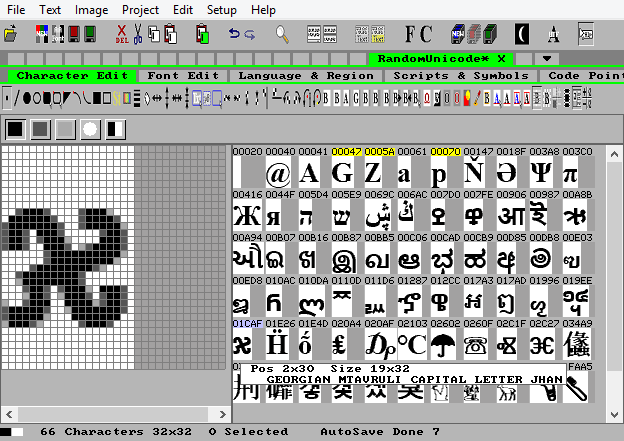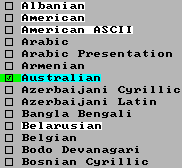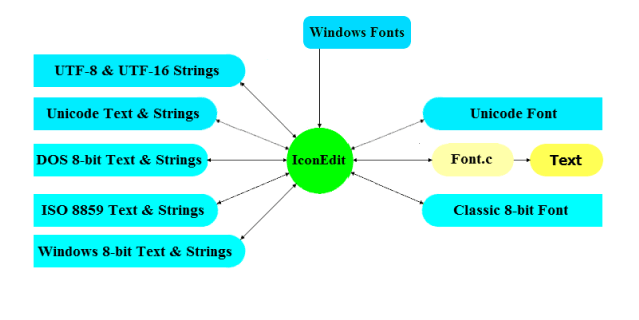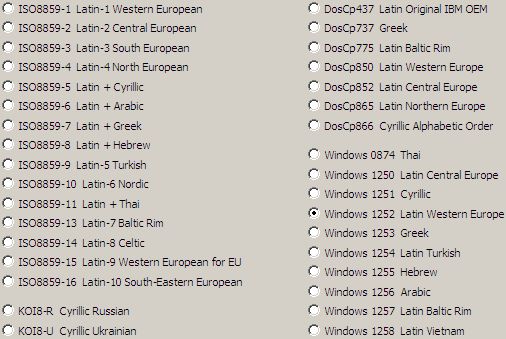International Unicode Fonts with many alphabets as C-source code
Create text optimized Unicode fonts for many languages.

Remove characters not needed by the texts in your application.
Or never include them in the first pace by opening a text string file.
Support for fonts and texts based on 16-bit Unicode and classic 8-bit code-pages.
IconEdit has extensive support for editing and manipulating Unicode fonts for multiple languages.
Fonts can be text optimized so only the characters used in the texts are in the font. This can give great savings in memory space for languages with many characters such as Chinese, Japanese, and Korean.

Make 16-bit Unicode fonts for any language supported by your TrueType, ClearType, or European and Asian Font Library fonts, and display your text examples with the created font.
Easy language selection
Select the languages needed during editing, and the character symbols are immediately added to your font:

Any languages already included in the font are highlighted in white for easy reference.
Special Eastern Asiatic language selection
Eastern Asiatic languages use very large alphabets. Unicode defines 80000 Japanese/Chinese and 11000 Korean ideograms for the languages.
Only a part of these are in normal use.
In the IconEdit Language selector, you can select fonts with only normally used ideographs:

This selection will create a subset of 3500 ideograms for Chinese basic education level.
Font manipulation.
- Use existing True-Type, Clear-Type, European or Asian Library fonts, or BDF fonts as inspiration for new bit-mapped fonts. Convert Windows True-Type and Clear-Type fonts to bit-mapped fonts for easy use with embedded systems.
- Support for font conversion to the pixel resolution most optimal for a specific display module.
- Create pixel fonts with 8, 4, 2, 1-bit intensity level anti-aliased symbols or B&W symbols for embedded application.
- Create proportional fonts or mono-spaced fonts, IconEdit has easy conversion between the two types.
Character manipulation.
A character in a font consists of the graphic symbol (the glyph) and the digital character value (the code point).

The character values (code points) for each character are displayed above the character symbols.
- Delete or add font characters and symbols without changing the code point. IconEdit automatically keeps the symbol and the code point synchronized.
- Create new fonts with the same character set but another look just by opening the code point file and choosing a new look.
- IconEdit makes it easy to copy groups of font symbols from one font to another via the clip board.
- Cut and Paste characters without losing the code point.
Edit characters individually or as a selected group.

Tools for modifying characters include:
- mono-space
- left-set
- right-set
- add or remove character spacing
- top-set
- redraw with master font
- invert
Convert texts and fonts between Unicode and classic 8-bit code-page encoding for old 8-bit compiler support
IconEdit is a 16-bit Unicode based font editor and all input, editing, and output is done in Unicode unless chosen otherwise by the user.
IconEdit has support for conversion of fonts and texts both ways between 16-bit Unicode and classic 8-bit code-page fonts and texts.

On import, IconEdit can convert classic 8-bit code-page fonts and texts to Unicode.
On export, IconEdit can convert Unicode fonts and texts back to a classic 8-bit code-page font standard.
This conversion back is only possible if the 8-bit standard supports the necessary characters for the alphabet or language.
Convert between Unicode and the following DOS, ISO-8859, KOI8, and Windows code-pages:

With the font and text conversion IconEdit can support:
- Texts written in editors that save the text in 8-bit Windows, ISO-8859, or DOS encoding. Texts are converted to Unicode on import.
- Re-use and update of old 8-bit fonts, character symbols are moved to their Unicode code point on import.
- Support for compilers that support only 8-bit text strings, either by converting text and font back to classic 8-bit encoding, or by converting 16-bit Unicode text strings to UTF-8. The second way the compiler sees only 8-bit text strings, and the RAMTEX GLCD driver library converts the UTF-8 strings back to 16-bit Unicode before writing the text. This means it is possible to use 16-bit Unicode texts and fonts by an 8-bit compiler.

